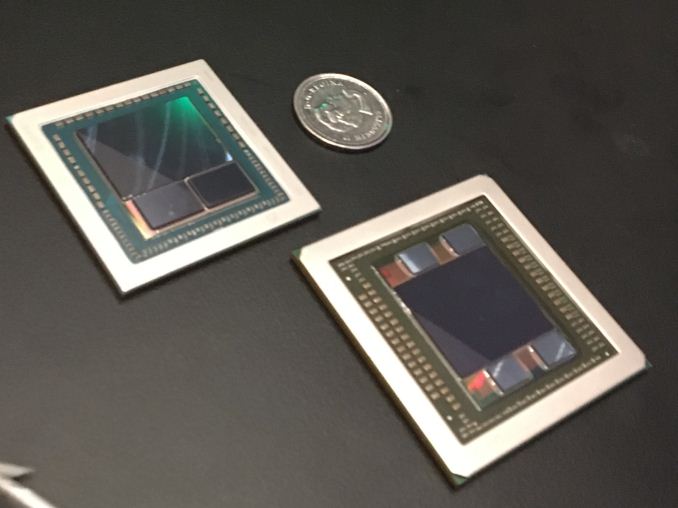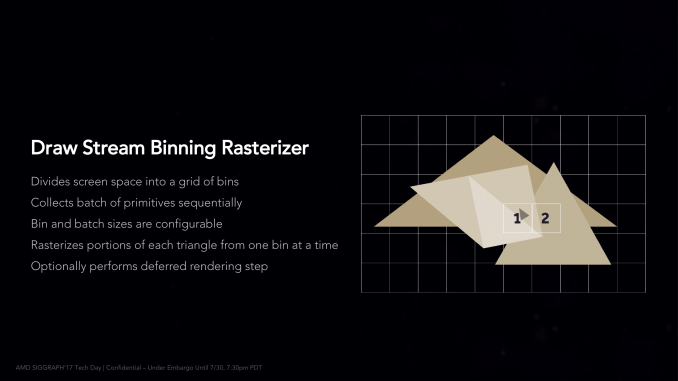Radeon RX Vega Unveiled: AMD Announces $499 RX Vega 64 & $399 RX Vega 56, Launching August 14th
by Ryan Smith on July 30, 2017 10:30 PM ESTFeatures & the Future Launch
Last but not least, along with today’s card announcements, AMD has also lifted the embargos on the architectural elements of the Vega 10 GPU. While there are no new architecture features to discuss – it turns out AMD was rather thorough with their preview at the start of this year – there’s still quite a bit in the way of details to dig into here. In fact it's more than I can hope to cover in a single day, let alone the few hours I’m getting to write this article ahead of AMD’s embargo. So I want to hit the highlights.
First and foremost, AMD has clarified that they do not consider Vega 10 to be a high performance computing (HPC) chip, unlike Hawaii. In particular, Vega 10’s native FP64 rate is just 1/16, like AMD’s other consumer chips. And the chip, while supporting HBM2’s native ECC mode, doesn’t have ECC on its internal pathways. This doesn’t mean that the chip can’t be placed in a server – its FP16 and INT16/INT8 performance is the cornerstone of its existence as part of the Radeon Instinct family. But that’s still a different market than traditional HPC. When we might see another HPC chip from AMD is anyone’s guess at this moment.
Second of all, we have a formal die size and transistor count for Vega 10. The GPU is officially 486mm2, containing 12.5B transistors therein. That amounts to 3.9B more transistors than Fiji – an especially apt comparison since Fiji is also a 64 CU/64 ROP card – all the while being 112mm2 smaller than Fiji (despite the higher transistor count) thanks to the higher density of GloFo’s 14nm LPP process, which AMD is using to fab the chip.
Talking to AMD’s engineers, what especially surprised me is where the bulk of those transistors went; the single largest consumer of the additional 3.9B transistors was spent on designing the chip to clock much higher than Fiji. Vega 10 can reach 1.7GHz, whereas Fiji couldn’t do much more than 1.05GHz. Additional transistors are needed to add pipeline stages at various points or build in latency hiding mechanisms, as electrons can only move so far on a single clock cycle; this is something we’ve seen in NVIDIA’s Pascal, not to mention countless CPU designs. Still, what it means is that those 3.9B transistors are serving a very important performance purpose: allowing AMD to clock the card high enough to see significant performance gains over Fiji.
Speaking of Fiji, there’s been some question over whether the already shipping Vega FE cards had AMD’s Draw Steam Binning Rasterizer enabled, which is one of the Vega architecture’s new features. The short answer is that no, the DSBR is not enabled in Vega FE’s current drivers. Whereas we have been told to expect it with the RX Vega launch. AMD is being careful not to make too many promises here – the performance and power impact of the DSBR vary wildly with the software used – but it means that the RX Vega will have a bit more going on than the Vega FE at launch.
Fifth, AMD is tweaking their boost clock mechanism and how it's advertised. Up until now, the boost clock was the maximum clock a Radeon card would hit. e.g. a stock Fury X topped out at 1.05GHz, and a stock RX 580 at 1340MHz. Starting with Vega RX, however, the company's definition of the boost clock is changing to the highest clockspeed a card is guaranteed to hit, but not the absolute highest clockspeed it can hit under load. There are still some nuances I want to test once I have the hardware in-hand, but at first glance this sounds closer to NVIDIA's definition, where each and every card is allowed to reach its natural limit (for the stock voltage).
Finally, while AMD didn’t clarify exactly when this change was made, the company has tweaked their Freesync Low Framerate Compensation technology to work with monitors that have a 2x range between min and max refresh rates, as opposed to 2.5x at launch. I’m told that 2.5x (or better) is still the ideal range, but it now works at 2x. This is an important development because the Samsung CF791 monitor that AMD is discounting as part of the Radeon Pack bundles has a 48Hz to 100Hz range; so it wouldn’t have been LFC capable under the old LFC rules.
Overall AMD has given us a lot to chew on – and more that can be covered in a single afternoon – but we still haven’t seen the whole picture. Today’s announcement of the card specifications and prices sets a very important baseline for what we should expect on August 14th, but no hard performance numbers to judge the final product. As I said at the start of this article, AMD’s marketing has done a very good job keeping Vega in the public’s mind. And today’s announcement is the next phase of that plan. But the end is approaching, and RX Vega’s full launch is drawing near, so it will be very interesting to see how everything we’ve learned over the last several months translates into gaming performance, power efficiency, and where AMD’s new place shall be in the realm of high-end video cards.













162 Comments
View All Comments
Kjella - Monday, July 31, 2017 - link
I bought the 1800X too, if they'd have spilled the beans on Threadripper a little earlier I might have waited for that. Vega? Sorry I smelled that hype train far away, think it scared nVidia a bit though because I think they saw Zen and thought AMD is on fire let's secure sales while we can because the 1080Ti for $700 carried an extremely small premium to be the top card. AMD releasing a card trading blows with the 1080 at 300W+ five months later? My guess someone at nVidia is kicking themselves for not making it an $8-900 card. "Only" 250W on air, 11GB RAM, HDMI 2.0b/DisplayPort 1.4 out and usable framerates at 4K without SLI and the long lifetime of DX12/Vulkan makes me think it's an investment I don't want to replace any time soon. It's probably an okay value card to keep AMD in the loop, but nothing more. Hopefully Threadripper and EPYC will keep them floating to come up with something better.lordken - Monday, July 31, 2017 - link
what does ryzen has anything to do with Vega (PR) failure?Nobody doubt ryzen (except hardcore intel fanboys), ryzen/tr/epyc all looks great and ryzen is on my list for upgrade.
Jimster480 - Monday, July 31, 2017 - link
The main problem is the number of ROPs.It was the problem in the Fury and it will be the problem here.
If they want more FPS they need to add more ROPs.
Ej24 - Monday, July 31, 2017 - link
Yeah it's strange, their entire gpu pipeline is massively wide except the rops on the backend. They're always rop starved.bug77 - Monday, July 31, 2017 - link
Yet I have it from one of their own engineers that they have no indication of any ROP bottleneck. Go figure...vladx - Monday, July 31, 2017 - link
And Raja told me himself that's not true... See how easy that is?Lord of the Bored - Tuesday, August 1, 2017 - link
They could make the second longer. And raise the speed of light while they're at it.extide - Monday, August 14, 2017 - link
It's not the ROP's. Fiji always killed it in fillrate tests, which basically test the ROP's. In Fiji, at least the main bottleneck was the Geometry engines.guidryp - Monday, July 31, 2017 - link
It is exactly that they tried to put lipstick on a pig that so pisses me off.vladx - Monday, July 31, 2017 - link
"It is exactly that they tried to put lipstick on a pig that so pisses me off."It's not like it's something new to AMD, they've being doing this overhyping thing for ages.